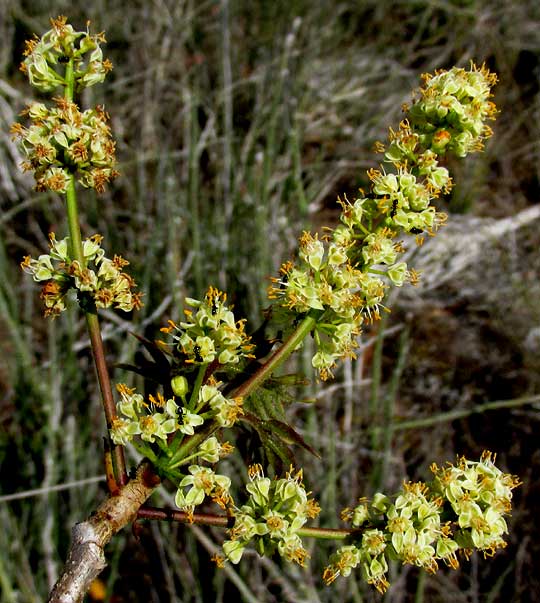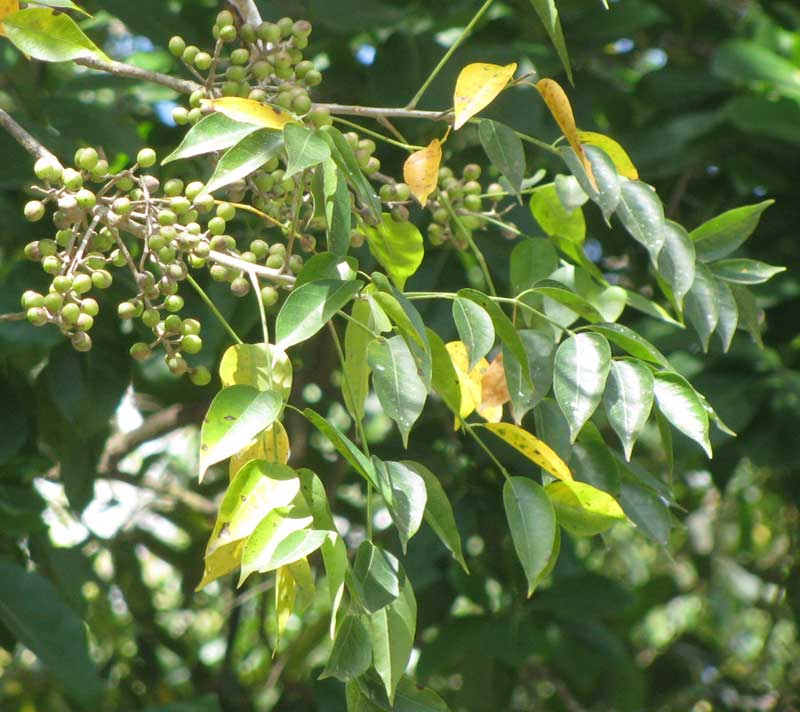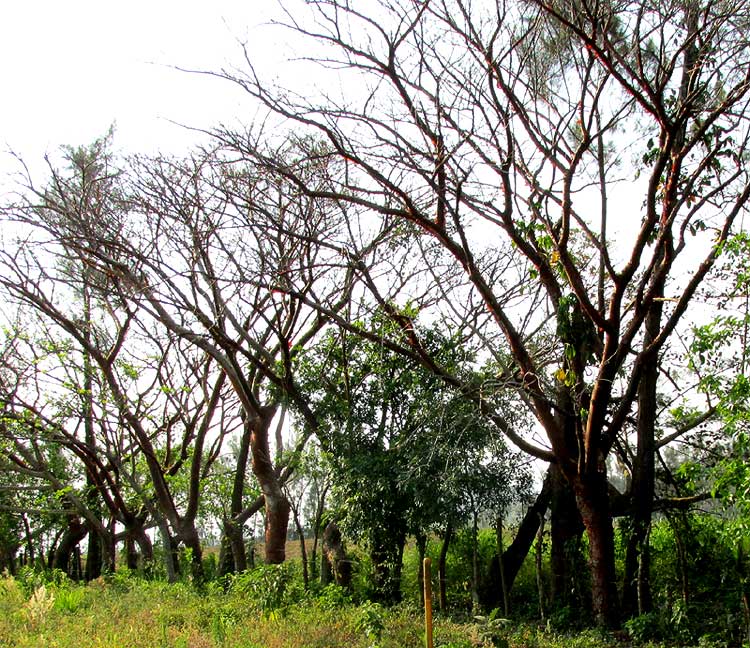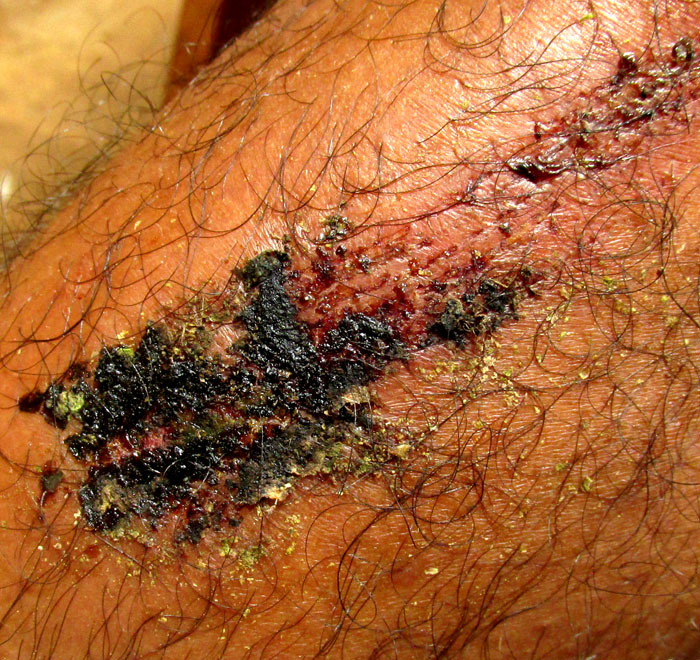Excerpts from Jim Conrad's
Naturalist Newsletter
from the May 17, 2015 Newsletter issued from Río Lagartos, on the Yucatan Peninsula's northern coast (~N21.60°, ~W88.16°), Yucatán state, MÉXICO
GUMBO-LIMBO/CHAKAH FLOWERING
The Gumbo-Limbo, locally called Chakah and technically BURSERA SIMARUBA, is one of the most commonly encountered trees in humid, tropical Mexico. Now at the very hot, dry end of the dry season, Gumbo-Limbos are among the trees issuing flowers despite the continued absence of rain, possibly with the strategy of having ripe fruits ready for dissemination when the rains do return -- which is any time. The Gumbo-Limbo's flowering is eye-catchingly prodigious, as shown below:

Though the tree's amassed flowers can be seen from afar, the individual blossoms are small, but tightly clustered in spike-like, panicle-type inflorescences, as seen below:

In the above photo you see that the season's fresh-looking, compound leaves also are emerging, and you wonder how a tree can be issuing such lushness while rooted in powdery-dry soil and daily having blisteringly hot air gush around it.
In our last Newsletter we found ants abounding among Black Mangrove flowers. Then we quoted researcher V. Rico-Gray's statement that "... during the dry season in coastal Yucatan, ants will rely on the nectar produced on the flowers and other reproductive structures as their main liquid energy source." Supporting this observation, now we find Gumbo-Limbo flowers crawling with ants, shown below:

Not until the above flowers were looked at under magnification was it apparent that the blossoms' male stamens were robust but no female parts were in evidence. Seeing that, I got curious and learned that Gumbo-Limbos are "dioecious" (male and female flowers on separate plants) or "polygamodioecious" (having bisexual and male flowers on some plants, and bisexual and female flowers on others). Bisexual flowers are those with functioning male and female parts in the same blossom. Gumbo-Limbos, then, produce three kinds of flowers: strictly male ones; strictly female ones, and; bisexual ones. Bisexual flowers also are known as "perfect" and "hermaphroditic."
Learning this, I went out looking for Gumbo-Limbos with more developed female parts. It was easy to find a tree bearing the flowers shown below:

The green, spherical items are ovaries, the future fruits, which were absent in the previous photo. Since both male and female parts in these flowers are well developed, I'm assuming that they're bisexual blossoms.
After examining about 20 flowering Gumbo-Limbos, I find that about three out of four trees bear nothing but male flowers, with the remaining blossoms being bisexual. No flowers that I judged as strictly female were encountered. This skewed distribution of flower types was intriguing. Why so many males? Is it always like this, or only when we're having an especially dry, hot dry season? Most trees examined were small, on very thin limestone so could it have been that very young trees only produced male flowers? I'd failed to notice that. Would the same flower-type distribution appear if we'd been having plenty of rain?
What a nice research project this would make.
Whatever the case with the Gumbo-Limbo's sexuality, ants sure benefit from its generous supply of nectar, and I benefit from seeing the trees' confidence that soon the rains will return.

from the March 25, 2012 Newsletter issued from Hacienda Chichen Resort beside Chichén Itzá Ruins, central Yucatán, MÉXICO
GUMBO-LIMBOS HEAVY WITH FRUIT
Gumbo-Limbos, BURSERA SIMARUBA, are among our most common trees here, as they are in much of humid, tropical Mexico. The trees produce abundant, pea-sized fruits, as seen above. That picture shows that Gumbo-Limbo's pinnately compound leaves (5-13 leaflets) are very similar to those of the North's ash trees, except that they're alternate (one compound leaf per stem node) instead of opposite (two leaves per node), as found among the ashes.
For years I've been waiting for a picture of a Gumbo-Limbo tree bearing mature fruits. I never got one, however, despite heavy yearly fruit crops. Now I understand: Birds, squirrels and other critters so relish the fruits that they eat them before they look ripe, at least to my eyes. As the above picture was being taken several Social Flycatchers as well as a Masked Tityra were gorging themselves, one fruit after another, though on the whole tree I couldn't spot a single fruit whose flesh I considered ripe. Biting into the ripest fruit available, I found the flesh green, hard and bitter, with a pungent taste somewhat between menthol and pine resin. Gumbo-Limbo wood has a resiny smell, too.
On the whole tree I found only one dark-red, three-angled seed on its pedicle, its flesh stripped from around it. You can see it at the top, right corner below:

from the March 17, 2007 Newsletter issued from Sierra Gorda Biosphere Reserve, QUERÉTARO, MÉXICO
GUMBO-LIMBO BARK
With so many trees and bushes leafless because of the dry season, one common tree here is more conspicuous than usual because of the striking, reddish bark peeling from its green-to-gray trunks, as you can see below:

Since the tree is so attention-getting and is present in so many tropical-American countries (southern Florida, Mexico and the West Indies to northern South America) it's known by many names. When I lived in Belize I heard people call it Naked-Indian Tree because of its reddish color, and Tourist Tree, because its trunk peels like a sunburned tourist. Books often call the species Gumbo-limbo. Both here and in the Yucatan it's called Chakah. It's a member of the little-known, tropical Bursera Family.
Gumbo-limbo's leaves look like pinnately compound ash- tree leaves, except that they are alternate on the stem, not opposite. The tree's small, inconspicuous, greenish flowers produce elliptic, half-inch-long, dark red fruits eaten by certain birds.
The tree is brittle and juicy, and its sap smells a little like turpentine. I read that in the Caribbean people use its resin as glue, varnish, water-repellent coating, and incense. Gumbo-limbo is considered medicinal nearly everyplace it grows. A site reviewing the tree's "ethnomedical" uses and listing 22 of its names is at http://www.rain-tree.com/gumbo.htm.
What impresses me about the species is that it's so flexible in terms of habitat requirements. You find it holding its own in fairly undisturbed forests as well as appearing as a "weed tree" along roads and in chopped-over cornfields. In southern Florida it makes a handsome street-tree.
I like tough, adaptable beings. After humankind finishes destroying the environment, if anything is left alive, it'll be adaptable weeds, cockroaches and such. Maybe someday Gumbo-limbo will constitute almost-pure forests all through the Earth's tropical zone, from Alaska to Tierra del Fuego.
notes from the May 3, 2015 Newsletter describing traveling through the Tuxtlas region of southern Veracruz, México
FENCE TREES
Surely the most abundant of all trees in Veracruz state as well as much of the rest of lowland, humid, tropical Mexico is the species shown below:

You can see that here during the late dry season the trees are mostly leafless, but even at this distance it's easy to recognize who the trees are. The main field mark is that they've been planted in a line, with barbed wire tacked to their trunks so that they serve as living fence posts, and the other item to notice is that their bark is dark reddish, and smooth but flaky.
My pirate taxi driver into San Andrés Tuxtla called it Morena but back in the Yucatán it's called Chakah, and local guides dealing with tourists sometimes call it Naked Indian Tree or Tourist Tree, the latter because its trunk blisters like a sunburned tourist. It's BURSERA SIMARUBA of the little-known, tropical Bursera Family.
One reason the tree is so commonly encountered is that it's a tough, adaptable species able to endure many abuses. Just poke a stick of it into the ground, it roots, and makes a new tree. Living fences such as the one in our picture are the norm throughout tropical Mexico wherever there's enough rain for them and it doesn't get too cold. Another reason for their abundance is that over the years various reforestation programs have provided seedlings to country folks willing to plant them. The tree's wood is too watery to make good firewood, and too weak and brittle to be good building material, but its fence-post service and the cool shade it produces endears it to everyone.
issued February 20, 2020 from Tepakán, Yucatán, MÉXICO
GUMBO-LIMBO RESIN FOR BEESWAX, SCRAPES & CUTS
Meeting my neighbors Jesús and Antonio Cen, who keep hives of stingless Melipona bees, I remembered to ask them about some regular honeybees I'd seen appearing to search for something on the trunk of a Chakáh or Gumbo Limbo tree. That common tree produces an aromatic resin, so maybe the honeybees were searching for resin for making wax? The brothers thought so. When I expressed pleasure at finding yet another use for this wonderful tree, Jesús pulled up his trouser leg and showed me the bad scrape shown below:

Jesús had treated the wound with freshly oozed Chakáh resin, which healed the wound amazingly soon, with no pain or infection.
Then Antonio showed me a bad machete-cut scar on his hand. It'd been a deep one that most people would have had sewn up, but when he applied Chakáh resin to it and it hardened, it puckered the skin together as if it were stitched up and the wound healed so quickly no further attention was needed. One problem with Chakáh resin, he said, was that if it gets wet, it dissolves and runs off. If you use a lot and it hardens, it's like a cast that cracks or breaks, especially at joints.